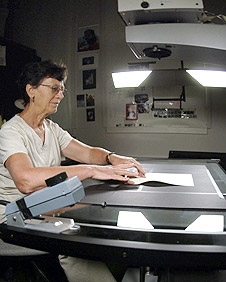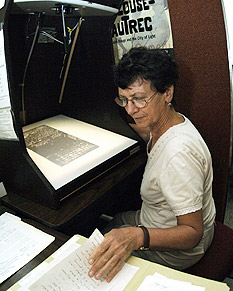
Preservation Microfilming
1 Standards & Guidelines | 2 The Filming Process | 3 Identifying Your Microforms
Alongside digitization, preservation microfilming remains an established and valued strategy for producing copies of deteriorated paper-based collections.
In the late 1980s, the National Endowment for the Humanities (NEH) funded a national Brittle Books Program to reformat deteriorated books via preservation microfilming. That program continued for over twenty years, and microfilming is still a funded activity through the NEH Humanities Collections and Reference Resources program. The purpose of microfilming is similar to that of digitization: for collections that have greater informational value than artifactual value, and for those with such tremendous artifactual value and/or fragility that they should not be routinely handled by researchers, microfilming provides an access surrogate for the original item.
While microfilm is clearly no longer the most user-friendly medium for access, it is the product of a tested technology with active standards and guidelines. It provides a master copy from which relatively inexpensive duplicates can be easily made. And unlike digital media, which cannot be read without computer access, microfilm can be read by the naked eye with only a light source and magnification.
1 Standards and Guidelines
Microfilming is governed by a variety of standards, but it is important to keep in mind that most of these standards were developed for commercial microfilming applications, where the microfilm being produced is only retained for a limited time. Thus, certain practices may be acceptable in the production of commercial microfilm that are not appropriate in the production of preservation microfilm.
General Microfilming Standards
Preservation filming is not a high priority for organizations producing industry standards, because it makes up only a small fraction of the micrographics trade. The American National Standards Institute (ANSI) issues various standards pertaining to imaging materials, including microfilm, and the Association for Intelligent Information Management (AIIM) also issues standards for micrographics. These standards can be useful in providing general information, but it is up to the individual institution to decide what level of quality is acceptable for their collections.
Guidelines for Preservation Microfilming
For specific guidelines for preservation microfilming geared toward libraries, archives, and other institutions that hold paper collections, the Research Libraries Group (RLG) has produced three publications that have come to be considered de facto standards. The RLG Preservation Microfilming Handbook (1992), the RLG Archives Microfilming Manual (1994), and the RLG Guidelines for Microfilming to Support Digitization (2003) should be consulted by any cultural institution planning a preservation microfilming project. Another basic resource is the Association of Research Libraries' Preservation Microfilming: A Guide for Librarians and Archivists (1996). All of these publications are referenced in Additional Resources.
These guidelines specify materials and procedures that must be used to ensure the permanence of the film that is produced:
- Film type: All preservation microfilm must be produced on a polyester base. Types of film include silver gelatin (the most stable); diazo and vesicular (less expensive, but not as stable); continuous tone microfilm (a silver gelatin film that can be very stable and is used for filming photographs and similar materials), and color microfilm (Ilfochrome color film, which likely has a lifetime of several hundred years in dark storage).
- Film format: The RLG guidelines are based on the 35mm roll film format, which provides a larger, better-quality image than microfiche or 16mm film.
- Film generations: Three generations of microfilm must be produced: the camera negative (e.g., the film used in the camera); a duplicate negative; and one or more positive service copies for researcher use and interlibrary loan.
- Film quality and processing: The RLG guidelines specify requirements for reduction ratio (the number of times the original is reduced); orientation of the image on the film; the legibility of the image (background density and resolution); processing of the exposed film; and inspection of the film and correction of mistakes (e.g., number of splices allowed).
2 The Filming Process
For most institutions, contracting out for microfilming services is the most efficient and cost-effective choice, since setting up an in-house lab to produce microfilm that conforms to standards and guidelines for preservation filming is extremely difficult and expensive.
The basic procedures involved in preservation microfilming are as follows:
- Preparing Collections for Filming—The materials are examined page-by-page to ensure that they are in the correct order and nothing is missing. Targets are created (informational sheets with bibliographic and condition information that are photographed with the item to assist the user), and reel breaks are determined. During the review process, special instruction for the filmers are noted. The materials are shipped to the vendor.
Filming—A planetary camera (where both the camera and the materials are stationary during filming) is most commonly used. Bound materials may be filmed using a book cradle. Manual exposure is usually necessary for collections with variations in paper color, texture, and/or ink.
Filming a document using a planetary camera.
- Film Processing—Silver gelatin film processors may be tabletop or deep tank models. They develop, fix, wash, and dry the film. Filmers should use control strips daily to check the performance of the processor.
- Polysulfide Treatment—This treatment was developed to combat the formation of redox spots or rings on silver microfilm, which are a result of poor environmental conditions and exposure to pollutants. Polysulfide treatment (which converts the silver to a form that better resists oxidation) can be used during initial processing. Alternatively, it can be provided for the master and duplicate negatives after all quality control inspections have been done, or it can be applied to older film, as long as the film is not yet deteriorated.
Quality Control—Before duplication, the master negative is inspected for proper resolution and density. A methylene blue test (for residual thiosulfate from processing) and a polysulfide test (as needed, if polysulfiding treatment was applied during original processing) are conducted, and the master negative is inspected frame-by-frame to ensure that each document has been filmed in the correct order and each frame is legible. If necessary, mistakes are corrected using ultrasonic splicing.
Quality control check.
- Duplication—The choice of film for duplicates will depend on cost and use patterns. Silver film is preferred for duplicate negatives, and should receive a polysulfide treatment. Diazo and vesicular films, which are cheaper and less prone to scratching than silver films, are often used for service copies. Duplicate films are inspected for resolution, density, and completeness as required in ANSI/AIIM and RLG standards and guidelines.
- Return of Film and Originals to the Institution—Original materials are generally returned at the same time to facilitate in-house inspection of the film, but master negatives should never be shipped in the same box, or on the same day, with their service copies or duplicate negatives. If possible, master negatives should be shipped by the vendor directly to off-site storage.
- Post-filming Activities—The institution must conduct in-house quality control inspections once the film is returned. These should include a general inspection of the film, packaging, and labeling, as well as a more comprehensive technical inspection that might include testing for density and resolution, as well as scratches, problematic splices, and other problems.
- Storage—Once materials have been filmed, house all preservation microfilm in archival enclosures, maintain microfilm readers regularly, and insist that researchers use the microfilm instead of the original materials. Master negatives must be stored off-site, preferably under the proper temperature and humidity conditions.
3 identifiying your microforms
Microforms (rolled microfilm and microfiche), like other film-based formats, were produced on different bases at different times. Very early microfilm on a nitrate base could be encountered, but this is highly unlikely. Microforms produced between the 1930s and the 1970s are likely to be on acetate base and thus may suffer from "vinegar syndrome," so called because of the distinctive odor given off in the deterioration process. From the mid-1970s onward, microfilm has been produced on a polyester film base; black and white polyester film has a life expectancy of 500+ years under proper storage conditions.
Types
Three of the most common microform types are described below; for more information on two less common types (electrophotographic or thermoplastic film and dry silver film), refer to the South Carolina Department of Archives and History leaflet Microfilm and Microforms.
- Silver-Gelatin (or Silver-Halide) Microforms: Based on the technology of black and white photography, when used in conjunction with a polyester base, these are the only "preservation-quality" microforms used for archival purposes. The image is produced by exposing light-sensitive silver compounds in a film emulsion to light; the resulting image is chemically developed. The emulsion side of this film is matte, while the non-emulsion side is glossy.
- Diazo Microforms: An acetate or polyester base is coated with an emulsion of diazonium salts, dye couplers, and a stabilizing agent; the film is exposed by UV light, which breaks down the diazo compound. Processed black diazo resembles silver gelatin film but is glossy on both sides.
- Vesicular Microforms: Diazonium salt coating is sandwiched between two polyester base layers. The film is exposed via contact printing from a master, and the image is developed by heating the film. This momentarily softens the base material and causes expanding nitrogen to form tiny bubbles (or vesicles) that remain when the film is cooled. Residual photosensitive material is then fixed by exposing the film to UV radiation, causing complete decay of the diazonium salts. Incident light passes through the clear areas of the film but is scattered and reflected by the bubbles, causing those areas with vesicles to appear dense.
Gauge
Microfilm comes in three widths or gauges: 16mm (typically used to film single page manuscripts), 35mm (used for oversized materials such as maps or newspapers as well as brittle books), and 105mm (used to make microfiche).
Formats
Rolled microforms are called serialized microforms and may be housed on reels, cartridges, or cassettes. Reel microforms are 16mm or 35mm and typically come in 100ft. lengths. Cartridge and cassette microforms are rare because of the special equipment needed on a microform reader.
Unitized microforms are microfilms that have been cut into units -- these include microfiche and jacketed microfilm. Microfiche is 105mm x 148mm (4" x 6") and contains multiple images in rows and columns. Jacketed microfilm are sleeves for multiple rows of microfilm and is typically utilized for records that are frequently updated.


